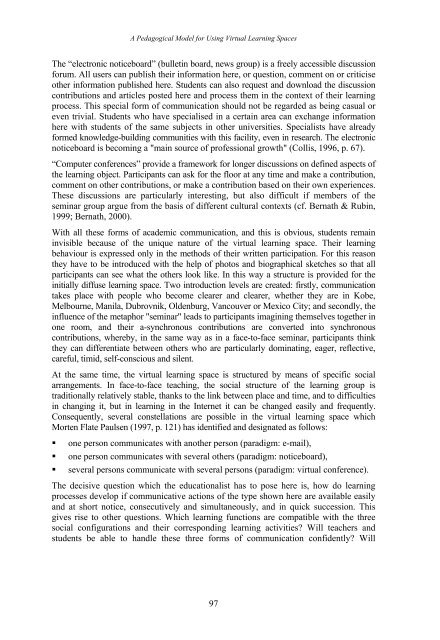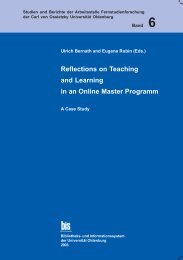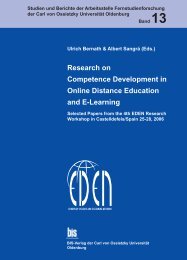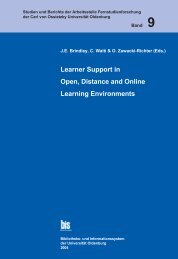Distance Education in Transition - Master of Distance Education ...
Distance Education in Transition - Master of Distance Education ...
Distance Education in Transition - Master of Distance Education ...
You also want an ePaper? Increase the reach of your titles
YUMPU automatically turns print PDFs into web optimized ePapers that Google loves.
A Pedagogical Model for Us<strong>in</strong>g Virtual Learn<strong>in</strong>g Spaces<br />
The “electronic noticeboard” (bullet<strong>in</strong> board, news group) is a freely accessible discussion<br />
forum. All users can publish their <strong>in</strong>formation here, or question, comment on or criticise<br />
other <strong>in</strong>formation published here. Students can also request and download the discussion<br />
contributions and articles posted here and process them <strong>in</strong> the context <strong>of</strong> their learn<strong>in</strong>g<br />
process. This special form <strong>of</strong> communication should not be regarded as be<strong>in</strong>g casual or<br />
even trivial. Students who have specialised <strong>in</strong> a certa<strong>in</strong> area can exchange <strong>in</strong>formation<br />
here with students <strong>of</strong> the same subjects <strong>in</strong> other universities. Specialists have already<br />
formed knowledge-build<strong>in</strong>g communities with this facility, even <strong>in</strong> research. The electronic<br />
noticeboard is becom<strong>in</strong>g a "ma<strong>in</strong> source <strong>of</strong> pr<strong>of</strong>essional growth" (Collis, 1996, p. 67).<br />
“Computer conferences” provide a framework for longer discussions on def<strong>in</strong>ed aspects <strong>of</strong><br />
the learn<strong>in</strong>g object. Participants can ask for the floor at any time and make a contribution,<br />
comment on other contributions, or make a contribution based on their own experiences.<br />
These discussions are particularly <strong>in</strong>terest<strong>in</strong>g, but also difficult if members <strong>of</strong> the<br />
sem<strong>in</strong>ar group argue from the basis <strong>of</strong> different cultural contexts (cf. Bernath & Rub<strong>in</strong>,<br />
1999; Bernath, 2000).<br />
With all these forms <strong>of</strong> academic communication, and this is obvious, students rema<strong>in</strong><br />
<strong>in</strong>visible because <strong>of</strong> the unique nature <strong>of</strong> the virtual learn<strong>in</strong>g space. Their learn<strong>in</strong>g<br />
behaviour is expressed only <strong>in</strong> the methods <strong>of</strong> their written participation. For this reason<br />
they have to be <strong>in</strong>troduced with the help <strong>of</strong> photos and biographical sketches so that all<br />
participants can see what the others look like. In this way a structure is provided for the<br />
<strong>in</strong>itially diffuse learn<strong>in</strong>g space. Two <strong>in</strong>troduction levels are created: firstly, communication<br />
takes place with people who become clearer and clearer, whether they are <strong>in</strong> Kobe,<br />
Melbourne, Manila, Dubrovnik, Oldenburg, Vancouver or Mexico City; and secondly, the<br />
<strong>in</strong>fluence <strong>of</strong> the metaphor "sem<strong>in</strong>ar" leads to participants imag<strong>in</strong><strong>in</strong>g themselves together <strong>in</strong><br />
one room, and their a-synchronous contributions are converted <strong>in</strong>to synchronous<br />
contributions, whereby, <strong>in</strong> the same way as <strong>in</strong> a face-to-face sem<strong>in</strong>ar, participants th<strong>in</strong>k<br />
they can differentiate between others who are particularly dom<strong>in</strong>at<strong>in</strong>g, eager, reflective,<br />
careful, timid, self-conscious and silent.<br />
At the same time, the virtual learn<strong>in</strong>g space is structured by means <strong>of</strong> specific social<br />
arrangements. In face-to-face teach<strong>in</strong>g, the social structure <strong>of</strong> the learn<strong>in</strong>g group is<br />
traditionally relatively stable, thanks to the l<strong>in</strong>k between place and time, and to difficulties<br />
<strong>in</strong> chang<strong>in</strong>g it, but <strong>in</strong> learn<strong>in</strong>g <strong>in</strong> the Internet it can be changed easily and frequently.<br />
Consequently, several constellations are possible <strong>in</strong> the virtual learn<strong>in</strong>g space which<br />
Morten Flate Paulsen (1997, p. 121) has identified and designated as follows:<br />
� one person communicates with another person (paradigm: e-mail),<br />
� one person communicates with several others (paradigm: noticeboard),<br />
� several persons communicate with several persons (paradigm: virtual conference).<br />
The decisive question which the educationalist has to pose here is, how do learn<strong>in</strong>g<br />
processes develop if communicative actions <strong>of</strong> the type shown here are available easily<br />
and at short notice, consecutively and simultaneously, and <strong>in</strong> quick succession. This<br />
gives rise to other questions. Which learn<strong>in</strong>g functions are compatible with the three<br />
social configurations and their correspond<strong>in</strong>g learn<strong>in</strong>g activities? Will teachers and<br />
students be able to handle these three forms <strong>of</strong> communication confidently? Will<br />
97





